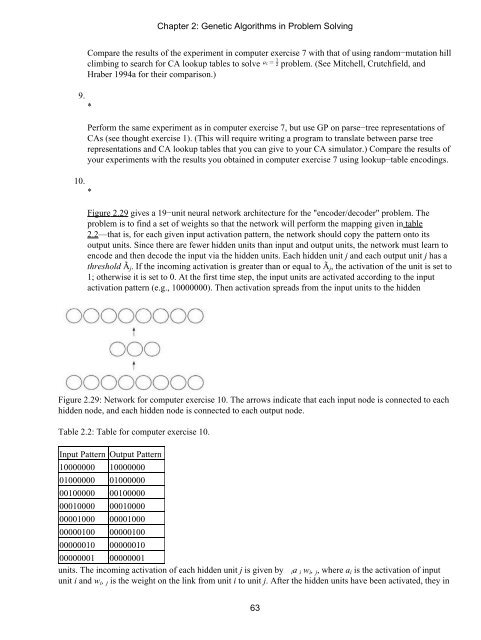An Introduction to Genetic Algorithms - Boente
An Introduction to Genetic Algorithms - Boente
An Introduction to Genetic Algorithms - Boente
Create successful ePaper yourself
Turn your PDF publications into a flip-book with our unique Google optimized e-Paper software.
9.<br />
*<br />
10.<br />
*<br />
Compare the results of the experiment in computer exercise 7 with that of using random−mutation hill<br />
climbing <strong>to</strong> search for CA lookup tables <strong>to</strong> solve problem. (See Mitchell, Crutchfield, and<br />
Hraber 1994a for their comparison.)<br />
Perform the same experiment as in computer exercise 7, but use GP on parse−tree representations of<br />
CAs (see thought exercise 1). (This will require writing a program <strong>to</strong> translate between parse tree<br />
representations and CA lookup tables that you can give <strong>to</strong> your CA simula<strong>to</strong>r.) Compare the results of<br />
your experiments with the results you obtained in computer exercise 7 using lookup−table encodings.<br />
Figure 2.29 gives a 19−unit neural network architecture for the "encoder/decoder" problem. The<br />
problem is <strong>to</strong> find a set of weights so that the network will perform the mapping given in table<br />
2.2—that is, for each given input activation pattern, the network should copy the pattern on<strong>to</strong> its<br />
output units. Since there are fewer hidden units than input and output units, the network must learn <strong>to</strong><br />
encode and then decode the input via the hidden units. Each hidden unit j and each output unit j has a<br />
threshold Ãj. If the incoming activation is greater than or equal <strong>to</strong> Ãj, the activation of the unit is set <strong>to</strong><br />
1; otherwise it is set <strong>to</strong> 0. At the first time step, the input units are activated according <strong>to</strong> the input<br />
activation pattern (e.g., 10000000). Then activation spreads from the input units <strong>to</strong> the hidden<br />
Figure 2.29: Network for computer exercise 10. The arrows indicate that each input node is connected <strong>to</strong> each<br />
hidden node, and each hidden node is connected <strong>to</strong> each output node.<br />
Table 2.2: Table for computer exercise 10.<br />
Input Pattern Output Pattern<br />
10000000 10000000<br />
01000000 01000000<br />
00100000 00100000<br />
00010000 00010000<br />
00001000 00001000<br />
00000100 00000100<br />
00000010 00000010<br />
Chapter 2: <strong>Genetic</strong> <strong>Algorithms</strong> in Problem Solving<br />
00000001 00000001<br />
units. The incoming activation of each hidden unit j is given by ia i wi, j, where ai is the activation of input<br />
unit i and wi, j is the weight on the link from unit i <strong>to</strong> unit j. After the hidden units have been activated, they in<br />
63






